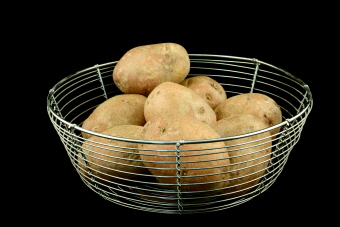Updated: March 24, 2020
Answering the question “how to store potatoes” is easy because potatoes keep better than most vegetables.
You can store them for months because they continue to live on after you pull them out of the ground (or off the grocery store shelf).
This is a good thing, too, because backyard gardeners often have a very successful potato harvest. It’s usually enough for even large families to avoid the less tasty store bought varieties for at least a few months.
Related: Can You Grow Potatoes in Autumn?
Another good thing is that storing potatoes properly is not hard – as long as you start with healthy potatoes. If you keep a few guidelines in mind, you should be able to keep your harvest until the last potato is gone.
Here are five guidelines on how to store potatoes:
Potato Storing Guidelines
1. Washing. Unwashed potatoes store better. If they’re muddy or excessively dirty, you can gently wash them with a hose. Just make sure they are completely dry before storing. Try to avoid scarring the skin because this invites problems. You shouldn’t wash them again until you are ready to eat them.
2. No light. Probably the most important storage concern is light. Potatoes exposed to light turn green due to chlorophyll.
A green potato indicates that it has excessive glycoalkaloids. In small amounts (no green showing) glycoalkaloids make potatoes taste bitter, giving them their distinctive taste. It also protects them from bugs.
In larger amounts glycoalkaloids will make you sick. You can’t just cut off the green part of the potato to remove the glycoalkaloids. I’ve eaten potatoes with some green in the past, but I was lucky.
It’s best to put green potatoes in the compost.
The ideal environment is to store potatoes in a paper bag that allows no light.

3. Temperature. Experts disagree on the proper storage temperature, but agree you should never freeze a potato. A storage temperature between 40 and 55 degrees Fahrenheit is probably best. This is probably the same temperature range as in the ground.
Temperatures on the low end of that range 40 to 45 degrees will cause sugars to form in the potato. Most people don’t like a sweet potato. It tastes strange.
On top of that, potatoes that have been stored in the low 40s or colder sometimes burn when fried. Temperatures above 55 degrees sometimes encourage sprouting or, worse, diseases. A cold basement of about 45 -50 degrees is probably best.
4. Humidity. Potatoes should be stored in a moist environment. Humidity of 98 percent will avoid “potato shrivel.” This is because potatoes are mostly water and decrease in volume when dry. Storing potatoes in a rolled up paper bag will help keep the humidity high. As mentioned above, it will also keep them dark.
5. Airflow. As we mentioned earlier, potatoes are still living, and like other living organisms they require oxygen and give off carbon dioxide. As such, air circulation is important when storing potatoes.
If you want to keep your potatoes good for a while don’t store potatoes in plastic bags (even bags with holes). That means if you buy potatoes in plastic bags, you should remove them from the bag and place them in a paper bag. This will go a long way to keep the moisture in the potato.
You also don’t want to store potatoes with apples. Both will get soft.
If you plan on storing potatoes for a few weeks, you don’t have to be too concerned.
If, on the other hand, you’d like to keep them for a month or more, these guidelines will come in handy.
For information on longer term storage of potatoes and seed potatoes, you can read the section on storing potatoes in Carol Deppe’s The Resilient Gardener on Google Books. The storing potatoes section is available online for free.
Related articles: